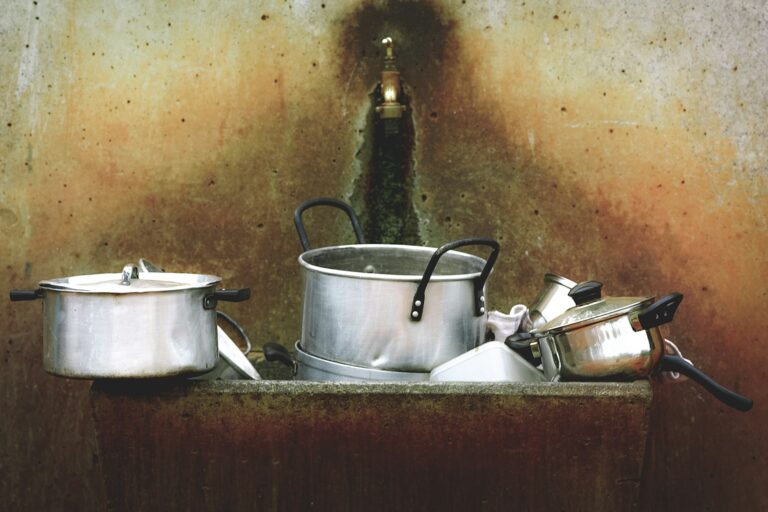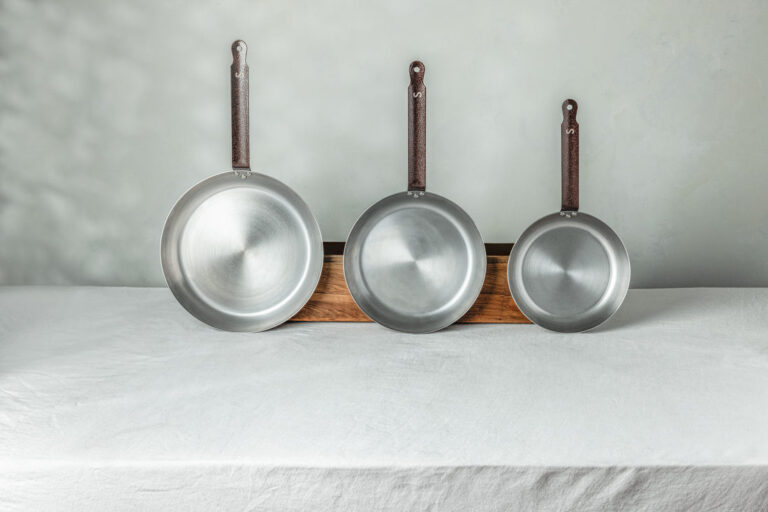I’ve always wondered which type of pan is better: aluminum or stainless steel. So, I decided to dig deeper and find out the pros and cons of each.
In this article, I’ll compare their heat distribution, durability, and ease of cleaning. By the end, you’ll have a better idea of whether aluminum or stainless steel is the right choice for your cooking needs.
Let’s dive in and discover which pan reigns supreme!
The Pros and Cons of Aluminum Pans
I’ve found that aluminum pans have their own set of pros and cons.
When it comes to cooking performance, aluminum pans have excellent heat conductivity, which means food cooks quickly and evenly. The heat distribution ensures that dishes are cooked to perfection.
However, aluminum can react with certain acidic or alkaline foods, causing a metallic taste. This can be avoided by using non-reactive coatings on the pan’s surface.
As for health concerns, there have been debates about the potential health risks associated with using aluminum pans. Some studies suggest that high levels of aluminum intake may be linked to neurological disorders.
To minimize any potential risk, it’s recommended to avoid cooking acidic foods for long durations in aluminum pans and to use stainless steel or non-stick pans for such dishes.
The Advantages and Disadvantages of Stainless Steel Pans
As for the advantages and disadvantages of stainless steel pans, they’re known for their durability and even heat distribution. However, they can be more expensive and prone to sticking.
When it comes to heat conductivity, stainless steel pans may not be as efficient as other materials like copper or aluminum. This means that they might take longer to heat up and distribute heat unevenly.
However, stainless steel pans have their own appeal in terms of aesthetics and appearance. They have a sleek and modern look that can enhance the overall look of your kitchen. Additionally, stainless steel pans are resistant to rust and corrosion, making them a long-lasting investment.
While they may have some drawbacks, I find that the advantages of stainless steel pans outweigh the disadvantages.
Comparing Heat Distribution: Aluminum Vs Stainless Steel Pans
When comparing heat distribution, I’ve noticed that aluminum pans seem to heat up faster and distribute heat more evenly than stainless steel pans. This is due to the fact that aluminum is a better conductor of heat than stainless steel. I have conducted several cooking experiments using both types of pans, and the results consistently show that food cooked in aluminum pans cooks faster and more evenly. Additionally, aluminum pans are generally more cost-effective than stainless steel pans. They are often cheaper to purchase and require less energy to heat up, making them a more cost-efficient option in the long run. Overall, if you are looking for superior cooking performance and cost effectiveness, aluminum pans are the way to go.
| Aluminum Pans | Stainless Steel Pans | |
|---|---|---|
| Heat Distribution | Fast and even | Slower and less even |
| Cooking Performance | Superior | Less effective |
| Cost Effectiveness | More cost-effective | Less cost-effective |
| Durability | Moderate | High |
Durability and Longevity: Aluminum or Stainless Steel for Your Pan
In my experience, aluminum pans tend to have a moderate level of durability and longevity compared to stainless steel pans. When it comes to rust resistance, aluminum pans have an advantage. I’ve noticed that aluminum pans are less likely to develop rust over time, especially when properly cared for. On the other hand, stainless steel pans may require more maintenance to prevent rusting.
In terms of price comparison, aluminum pans are generally more affordable than stainless steel pans. This makes them a popular choice for those on a budget. However, it’s important to note that stainless steel pans are known for their superior heat conductivity and even heat distribution.
Cleaning and Maintenance: Which Pan Is Easier to Take Care Of?
I find that aluminum pans are generally easier to clean and maintain compared to stainless steel.
The smooth surface of aluminum makes it less prone to food sticking, which means less scrubbing and scraping.
Stainless steel pans, on the other hand, tend to have a rougher surface, making it more likely for food to stick and burn.
When it comes to ease of use, aluminum pans win hands down.
As for cleaning, I recommend using gentle cleaning products such as mild dish soap and a non-abrasive sponge for both aluminum and stainless steel pans.
Avoid using harsh chemicals or abrasive cleaners, as they can damage the pans’ surfaces.
With proper care and cleaning, both types of pans can last for a long time.
However, if you prefer a pan that’s easier to clean and maintain, aluminum is the way to go.
Conclusion
In conclusion, both aluminum and stainless steel pans have their own advantages and disadvantages.
Aluminum pans offer better heat distribution and are lighter, but they may react with acidic foods.
Stainless steel pans are more durable and resistant to corrosion, but they tend to have uneven heat distribution.
Ultimately, the choice between aluminum and stainless steel pans depends on personal preferences and cooking needs.





